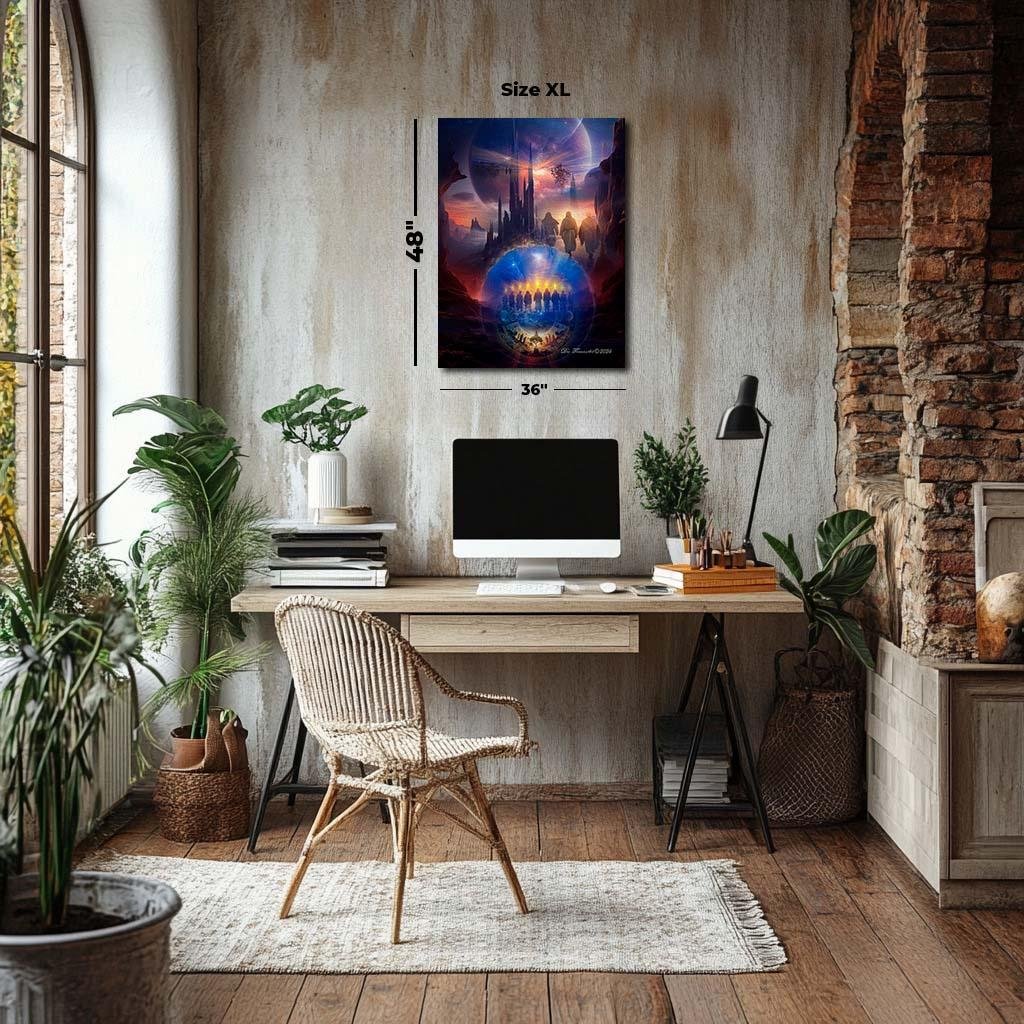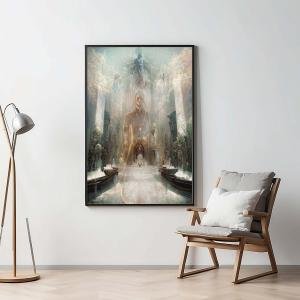Silent Tears Beneath the Heavens
This striking piece of art is a fusion of celestial realms and human figures, blending elements of the divine with the stark realities of life. The sky above is a cosmic expanse, filled with planets, stars, and glowing lights that suggest a far-reaching universe, perhaps one filled with mysteries and uncharted destinies. Rising from this dreamlike cosmos are dark, towering structures, resembling both ancient temples and futuristic cities.
Please see Below for Details…
Hotline Order:
Mon - Fri: 07AM - 06PM
404-872-4663
At the center, a group of robed figures walks toward the horizon, their silhouettes bathed in the golden hues of a setting sun. They seem to be on a sacred journey, leaving the terrestrial world behind as they move toward an unknown, illuminated future. Below them, an arc of figures stands, heads bowed, their faces hidden as they gather beneath radiant orbs of light. The scene is heavy with symbolism, as the circular arrangement of the figures beneath represents a cycle—perhaps of life, death, and the search for meaning. A tree sits centrally, rooted in this cosmic sphere, grounding the ethereal vision with a reminder of life’s continuation amid suffering.
The verses from Ecclesiastes 4:1-3 provide a sobering reflection on oppression, suffering, and the weight of human existence. In the context of the artwork, the figures can be seen as both the oppressed and the observers of the oppression, traveling through a desolate landscape where "there was power; but they had no comforter." The towering structures behind them could symbolize the systems of power that continue to cast their shadows over the earth, cold and indifferent to the plight of those who suffer beneath them.
The layers of this art evoke a sense of distance between the earthly pain and the celestial lights above—perhaps indicating how, even in the darkest moments, the heavens remain untouched, shining down but silent. The phrase "I praised the dead which are already dead more than the living which are yet alive" is symbolized through the figures walking away, as if leaving behind the weight of the world and its troubles, moving toward a place where suffering is no more.
In the glowing circle beneath the larger scene, the figures might represent souls who have passed on, now enlightened and free from the burden of earthly life. This reflects the sentiment that "better is he than both they, which hath not yet been," as the unborn are spared the knowledge of the suffering that exists under the sun. The vibrant lights above the figures represent hope, transformation, and perhaps spiritual freedom—a contrast to the darkness of the physical world.
The verses from Ecclesiastes remind us of the harsh reality of oppression and suffering in the world. By acknowledging this darkness, the artwork invites viewers to reflect on their own experiences with injustice and suffering. It encourages empathy for the oppressed and reminds us of the power structures that often cause this pain. In today's world, these verses still resonate as they call attention to the inequalities and struggles that persist across societies.
The praise for the dead over the living, and the unborn over both, offers a deep contemplation of the nature of life. It can lead one to reflect on the transient nature of human existence, helping us to appreciate the fleeting beauty and sorrow of life. In human life, such reflections can encourage individuals to live more mindfully, understanding that life is a delicate balance between joy and suffering.
The verses emphasize the absence of comfort for the oppressed, a reminder of the importance of compassion and support for those who are suffering. In the modern context, this aligns with the idea of seeking justice and being a source of comfort for others, whether through activism, community, or personal relationships. The figures in the artwork may represent those who seek solace in the face of overwhelming hardship, pushing us to consider how we might offer comfort in the real world.
While the verses speak of deep sorrow and existential weight, the radiant lights within the artwork suggest that even in the darkest of times, there is hope. The cosmic setting above the journeying figures could symbolize that the universe holds deeper meaning and, perhaps, divine plans that transcend human suffering. This is a message of hope, encouraging individuals to look beyond their immediate trials and trust in a greater purpose.
By merging these powerful biblical themes with vibrant, celestial imagery, "Silent Tears Beneath the Heavens" offers both a reflection on human suffering and a message of hope. It speaks to the timelessness of these struggles, yet also to the possibility of transcendence and peace, especially for those who have moved beyond the toil of earthly life.
Add your review
Your email address will not be published. Required fields are marked *
Please login to write review!
Looks like there are no reviews yet.








